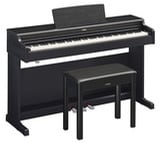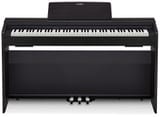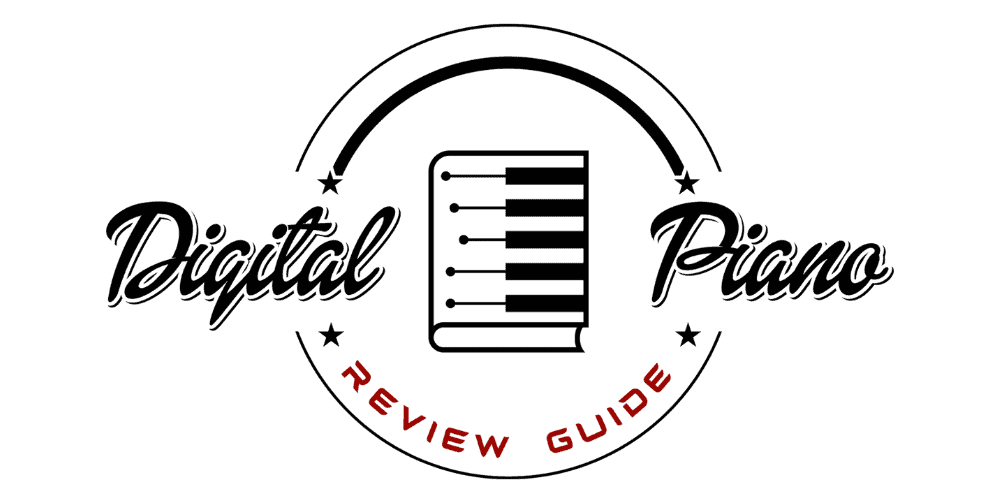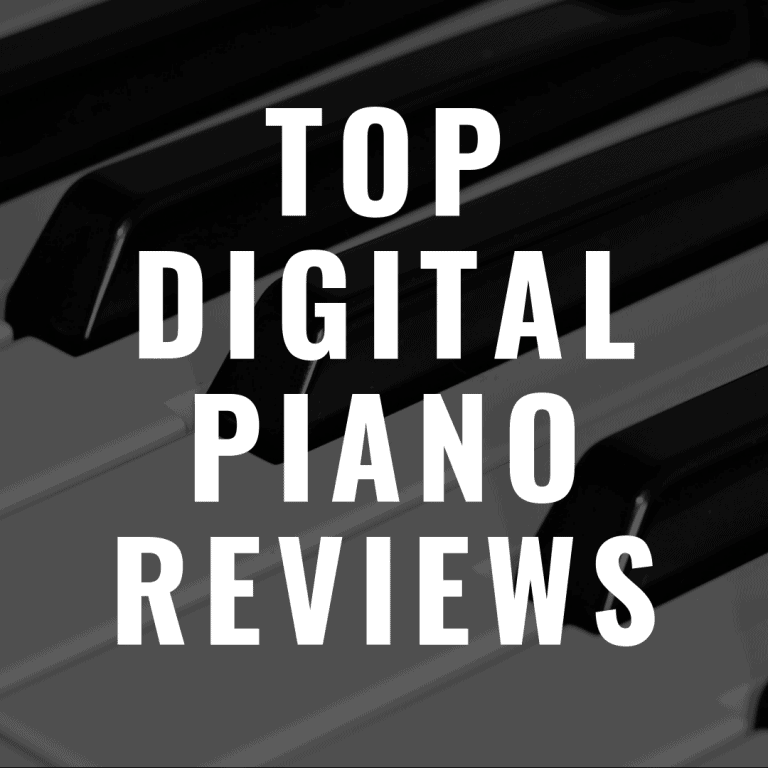What’s the Best Digital Piano Under $3,000?

A budget of $3000 gives you a good range of choice in the digital piano world. Digital uprights tend to be more expensive than stage pianos because they come installed with a housing unit that can be really beautiful or a completely functional body for a permanently placed instrument.
Stage pianos, by contrast are built for portability; Uprights become part of the furniture – and ultimately, the family.
In this article, we will be discussing some of our favorite digital pianos (both uprights and stage pianos) available for under $3,000. To better help you comparison shop, please take a moment to view the interactive table below which contains some of the digital pianos we will be discussing in this article.
| Photo | Model |
|---|---|
 | Yamaha CLP 735 |
 | Yamaha YDP 144 |
 | Casio PX-770 |
 | Yamaha YDP-165 |
 | Casio PX-870 |
 | Roland RP-102 |
What to Expect for Your Money
Spending $3,000 is now easy thing. And so, if you’re going to spend that much coin on a top tier instrument, here are a few basic things you should expect.
- 88-note keyboard
- Touch sensitivity – with timbral dynamic differentiation (as opposed to just loud and soft)
- Fully weighted keys
- Backlit LCD navigation display of some sort
- High quality sampling technology
- A play and feel close to a genuine acoustic instrument
The Important of Keys
For the most part, the $3000 range affords a high quality key play surface. Often, the surface quality is a synthetic ivory feel – often with a matte surface that absorbs finger moisture, increasing the tactility of play, and sometimes with a textured “wood” surface.
Some keyboards in this range are made with genuine piano keys, but this is, perhaps, usually only found in the very top end of this price range. A genuine piano key is wooden with a ivory-type covering.
A wooden key has a weight of its own in comparison to a lighter synthetic key made wholly from a plastic-based material. Wooden keys have a better feel underneath the fingers because some of the weight of the key lies in the body of the key.
You may find our article on key action helpful to read, which you can find here:

Below, please take a moment to view some of the best-selling digital pianos available online (and see how well they match up to the pianos we discuss in-depth in today’s article).
| BEST SELLERS |
|---|
| 1) Casio PX-770 |
| 2) Yamaha YDP-145 |
| 3) Roland RP-701 |
| 4) Yamaha YDP-165 |
| 5) Casio PX-870 |
Touch Sensitivity
Touch sensitivity is what gives an acoustic piano (whether grand or upright) its expressive interface between player and instrument. The ability to play dynamically (loud and soft) is key to the “human” feel of musical performance, so it’s an essential feature of a digital piano that you may use as a learning aid, or as an instrument to express yourself creatively.
No two people will play the same piece of music in exactly the same way – there is infinite variety in the dynamic and timbral qualities of a piece of music and an instrument that can read and and represent our individuality as musicians is mandatory.
Each of the manufacturers have their own systems for reading your dynamic play – mostly with multiple key sensors that trigger different samples depending on the combination of sensors triggered.
Fully Weighted Keys
Acoustic pianos are more than just the keyboard – the key triggers a mechanical chain of events involving a sequence of arms, levers and hammers and these equate to the weight of the key underneath the finger.
Digital pianos don’t need this complex system of mechanical devices to trigger the sound, so the challenge is to give the key a weight that is as genuine a representation of the real thing as possible. And each manufacturer has their own weighting system.
The arms, levers and hammers of grand pianos are generally longer and heavier at the bottom end (for the bass notes) than at the top end, where the play-feel is lighter. Many of the manufacturers in our price range have a keyboard with a “Graded Hammer Action” that certainly aims to emulate this quirk of the real instrument to create as real a feel for the musician as possible.
You may want to read our article on weighted keys entitled: What’s the Best Digital Piano with 88 Weighted Keys?
LCD Navigation System
No, this won’t direct you to the nearest restaurant, but it will give you a means of controlling the digital functions of the keyboard. Most navigation systems allow you to change instrumental voice, control various “ambient” controls (such as room reverb, lid position, damper sensitivity etc), as well as edit individual sounds. In this price bracket, the interface should be fairly user-friendly and easy to explore, providing quick access to on-board features.
Many digital keyboards in this price bracket also have on-board (or peripheral) Bluetooth connectivity,
High Quality Sample Technology
It barely needs saying that the digital piano should be capable of amazing sound reproduction, using state-of-the-art sampling technology. And at this price range, you can expect a beautiful reproduction of a grand piano (and a great selection of other instrumental voices).
Each manufacturer has their own “engine” driving the instrumental sound – I’ll go into these individually as I explore the instruments.
In this article, I’ll be exploring the pros and cons of the following instruments:
- Yamaha Clavinova CLP-635
- Roland FP-50
- Kawai CN27
- Nord Piano 3
- Yamaha YDP-181
Let’s begin by discussing the Clavinova CLP-635 by Yamaha.
Yamaha CLP-635
The Clavinova line is one of the most recognizable in the digital piano world, and for good reason. These are instruments that are built to last many years and can take quite a consistent battering (from the fingers – obviously, it wouldn’t last that long if you go at it with a hammer drill).

They’re great instruments for learners and experienced players alike.
The CLP-635 is in the lower-end of the Clavinova range, but is packed full of fantastic features and instrumental sounds. The piano sounds are driven by Yamaha’s CFX Binaural sampling engine, which offers samples from two amazing grand pianos – the Yamaha CFX and Bösendorfer’s Imperial grand.
Binaural sampling is achieved by recording the acoustic instrument with multiple microphones that create a 3 dimensional locational image of the instrument’s natural spatial qualities. In other words, low notes are amplified more from the left side of the instrument and the high notes, the right side.
So, Binaural respects this locational aural production. It’s got to be said that this is more obvious when you wear headphones, but it certainly does add an extra degree of realism to the feel of play.
The piano sounds are nice and have a genuine sense of spaciousness which is, I feel, Clavinova’s trademark. I can never quite decide whether I find the Clavinova piano sound a bit over-produced—although it can be adjusted. The default sounds are so drenched in reverb that it over-whelms the touch-sensitivity a little and can give you that uncomfortable feeling that you’re playing in a bathroom.
It comes down to personal taste, I think.
The CLP-635 comes with synthetic ivory and ebony keytops and a Graded Hammer 3X keyboard, which is heavier at the bottom end of the keyboard. The instrument is housed in a beautiful, furniture-quality unit that comes in a variety of finishes, including a polished ebony which is really lovely. There’s also a sliding piano lid and a music rest.
This is a great instrument for the learner, as there are a number of features that make for better piano lessons, including a split keyboard function that divides the keyboard in half, with both sides inhabiting the same octave range. If you’ve had a piano lesson on an acoustic piano, you’ll realize that your beautifully delicate melodic phrases sounds like a fairy-elephant stomping its way through your temple of calm when played at the bottom end.
There’s no built-in Bluetooth with this instrument, however, which really is a bit of an oversight. You can buy a Bluetooth adapter (UD-BT01), which could set you back another $80, so this could be a deal-breaker.
This instrument is certainly at the top end of your $3000 and will often be listed slightly higher. But shop around, because I’ve found some great deals out there and with some savvy shopping, you’ll find this instrument under $3000. It’s often worth going into the shop and having a bit of a haggle, because it can certainly pay off.
The search will be worth it.
Roland FP-50
Roland pianos have an amazingly light play feel and wonderful realistic sound qualities. Driven by their SuperNATURAL sound engine with multiple layers of dynamically triggered sampling, this is a keyboard that you’ll find yourself completely dedicated to.

The FP50 is a stage piano, but if you’re looking for something a little more permanent, you can purchase the optional stand and foot pedal board. It has to be said, that the stand is functional and won’t win any prizes in a beauty pageant, but who’s looking at the stand? This digital piano is something to behold in and of itself!
Not only does it have one of the best build qualities in the stage piano market, it also has a weighting technology that truly makes you forget that you’re playing an electronic instrument. With matte, synthetic “ivory feel” keys, this is an instrument that’s built with a sense of sturdy reliability that will provide many hours of great playing enjoyment.
The user interface is simple and easy to navigate, but it also comes with Bluetooth connectivity as standard, which gives you access to Roland’s catalog of free apps, as well as the multitude of synth apps available on the iOS platform. Additionally, you can assign a foot pedal of your choice to “turn the page” in sheet music apps, so they’ve pretty much thought of everything you could possibly want here.
The key weighting is amongst the best you can find in this price range, and the graded hammer action gives you the sense that you’re playing a genuine piano.
The instrument comes with 14 piano sounds, so there’s definitely going to be something to suit your needs, as well as 25 amazing electric pianos. The electric pianos featured in the FP-50 offer a wide array of genuine sounding Fender Rhodes-style instruments, complete with the crunchy distorted edge that gives the Rhodes its distinctive tonal flavor.
You can read our review of the Roland FP-50 here.
Kawai CN27
Kawai have been making acoustic grand pianos for almost 100 years, so there’s no surprise that this is a digital piano that offers an amazing playing experience.

The CN27 features super-responsive sampling of Kawai’s EX and SK-EX concert grand pianos which, when accompanied by the amazingly light keyboard build, combines to make a playing experience that takes you straight into the concert hall.
The onboard instrument set offers 8 brilliant pianos to choose from, ranging from the “bitey” immediacy of the upright pianos, to the mellower, warmer concert grand selections. There are some lovely electric pianos and organ sounds, so there’s plenty to keep you entertained and focused whilst playing music that you’ll fall in love with all over again.
The user-interface is a bit limited when you stand it next to its big brother, the CN37, but for the price, there’s not a great deal to grumble about because you get Bluetooth connectivity that opens up the world of apps, expanding the limited on-board interface with the free Kawai Virtual Technician app, which gives you far greater sound editing capability.
If you’re looking for a great instrument that offers tons of features for a reasonably conservative price tag, then the CN37 could be for you.
You can read our review of the Kawai CN27 here.
Nord Piano 4
Nord pianos are perfect for the gigging musician, but to write this off as just a stage piano is a folly. They can make great home pianos as well. This is an amazing piece of kit that will totally suit the gigging musician and the keen home player alike.

The general tech set includes an 88 key triple sensor keybed that perfectly translates your dynamic play into a pianistic experience filled with expression. The keys are weighted with a genuine hammer action that offers impressive authenticity to your control the instrument.
There’s 1GB of memory here that’s dedicated to the piano sounds alone. This offers a great reassurance that the expression you put into your performance is going to deliver with as much tonal color as it has dynamic range. There are 6 beautiful grand piano sounds that cover the whole spectrum, from bright and lively, to warm and mellow.
But, where Nord keyboards always come to life is with the additional sounds, with a great selection of funky electric pianos and clavs.
One of the most impressive features of the Nord 4 is the ability to upgrade the instrument set by connecting it to your computer and using the Nord Sound Manager (which is available for both Mac and Windows platforms) via USB. You can download new sounds and drag and drop them to your keyboard to play an endlessly expanding sound set.
Complete with an ADSR-based sound editor, this is the digital stage piano with the widest instrumental versatility. They are certainly expensive, though, and the look is quite retro with their distinctive in their red branding, so it may well clash with your curtains. You might get a more pianistic instrument from the other digital pianos listed, but if you’re looking for versatility, the Nord Piano 4 could be a contender for the best stage piano on the market under the $3000 range.
You can read our review of the Nord Piano 4 here.
Yamaha YDP-184
This Yamaha is part of the Arius lineup, which is generally considered entry-level, whereas the Clavinova is what you might call pro-level. So, expect fewer features with this instrument than with the CLP-635, but you’ll have to do less searching around for the deals that bring you comfortably under $3000.

What I particularly like about the Arius range is the surprisingly light feel of the keyboard. The Clavinova keyboard, certainly toward the lower end of the price range, seems to have a rather springy keyboard that doesn’t feel particularly pianistic to me. But the Arius line, (curiously, because it’s the cheaper little brother of the Clavinova) does seem to have the type of keyboard that feels light and bouncy and very pleasurable to play.
The feature set isn’t as expansive as the CLP-635, but that shouldn’t pose a problem because what you get with the YDP-184 is some really well sampled piano sounds (that don’t have the overly-processed feel of the Clav range) and enough to keep you entertained while you play.
Sometimes you just want a keyboard that does the job of playing without piling in the kitchen sink just because they can. So, for my money, the YDP-184 offers enough of the essential features and has shaved off many of the bits that you’d probably never use anyway.
What you don’t have you don’t miss. What you do have here, however, is a digital piano that has a great sound and a decent play feel.
Which is really all you need.
You can read our review of the Yamaha YDP-184 here.
Conclusion
There’s a ton of variety on the market when it comes to finding a digital piano under $3,000 that works for one’s needs. With that said, from a value standpoint (as well as great play feel and expansive potential due to its Bluetooth companion app), I really like the Kawai CN27.
The CN27 is a keyboard that feels amazing to play. OK, it has a fairly limited instrumental sound set, but Bluetooth offers a huge array of exciting options that enhance the playing experience. I’d go for the CN27 for a great combination of features and price, making it my favorite digital piano under $3K.
If you found this article helpful, please “like” us on Facebook!






